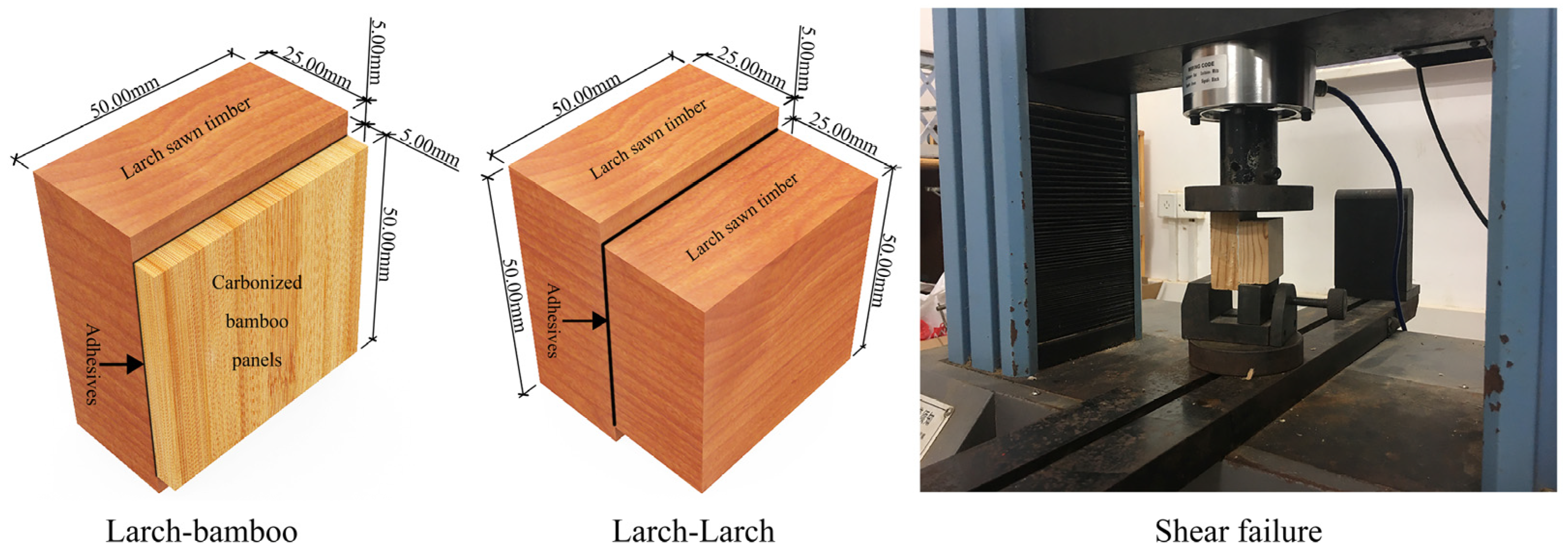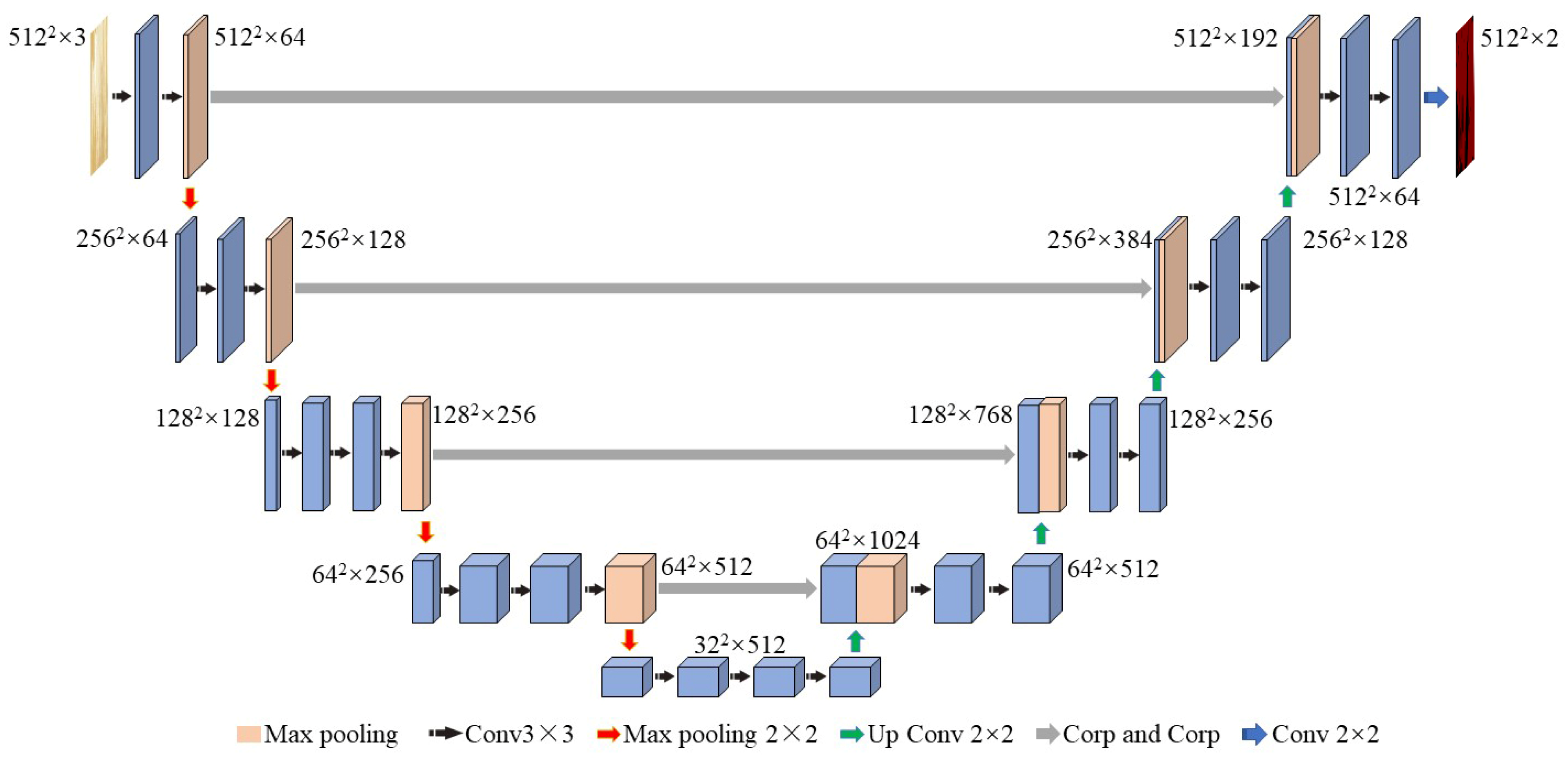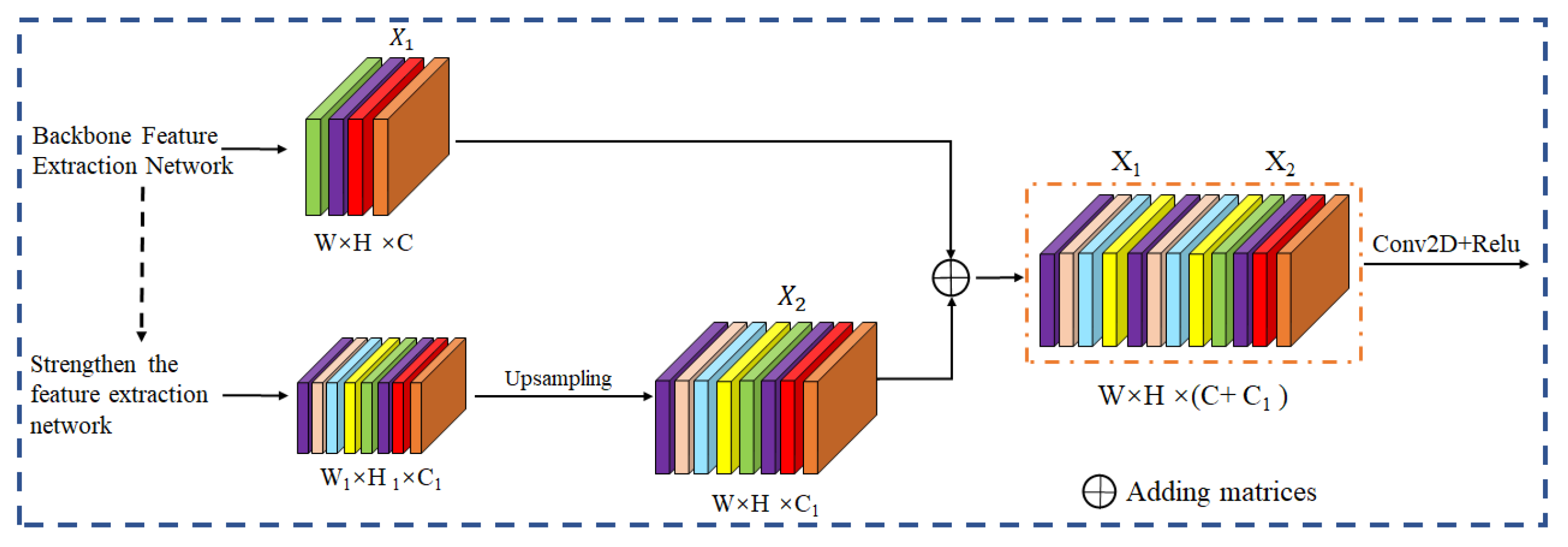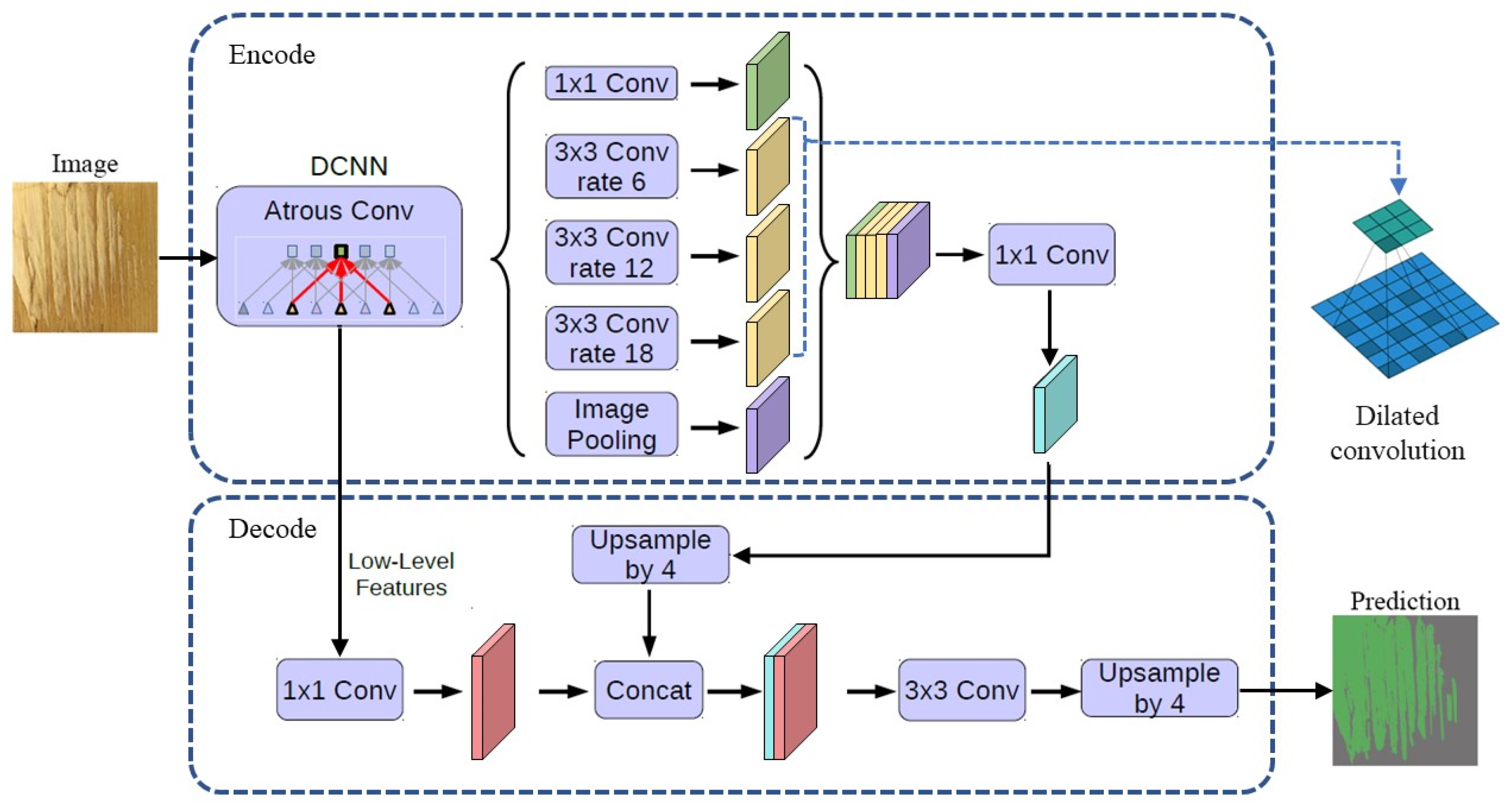Deep Learning Methods for Wood Composites Failure Predication
Abstract
:1. Introduction
2. Materials and Methods
2.1. Image Acquisition
2.2. Datasets
2.3. Methods
2.3.1. UNet Model
2.3.2. PSPNet Model
2.3.3. DeepLab_v3+ Model
2.4. Methods Validation
2.4.1. Experimental Environment
2.4.2. Model Parameters
2.4.3. Model Training
2.4.4. Evaluation Index of Semantic Segmentation Model
3. Results and Discussion
3.1. Analysis of Model Training
3.1.1. Results of Model Training of WFSI
3.1.2. Results of Semantic Segmentation of WFSI
3.1.3. Analysis of Model Prediction Results
3.1.4. Mechanisms for Predicting Wood Failure Surfaces
3.2. Performance Evaluation of the Proposed Algorithm for WFP Measurement
3.2.1. Measurement Accuracy
3.2.2. Measurement Speed
3.2.3. Measurement Stability
4. Conclusions
Author Contributions
Funding
Institutional Review Board Statement
Informed Consent Statement
Data Availability Statement
Conflicts of Interest
References
- Han, Y.; Park, Y.; Chang, Y.-S.; Chung, H.; Eom, C.-D.; Yeo, H. Improvement of shear strength, wood failure percentage and wet delamination of cross-laminated timber (CLT) panels made with superheated steam treated (SHST) layers of larch wood. Holzforschung 2017, 71, 873–879. [Google Scholar] [CrossRef]
- Michele, B.; Michele, B.; Marco, P.L.; Michela, N.; Francesco, R.; Benedetto, P. Comparison of newly proposed test methods to evaluate the bonding quality of Cross-Laminated Timber (CLT) panels by means of experimental data and finite element (FE) analysis. Constr. Build. Mater. 2016, 125, 952–963. [Google Scholar]
- ugmore, M.; Nocetti, M.; Brunetti, M.; Naghizadeh, Z.; Wessels, C.B. Bonding quality of cross-laminated timber: Evaluation of test methods on Eucalyptus grandis panels. Constr. Build. Mater. 2019, 211, 217–227. [Google Scholar] [CrossRef]
- Markus, K.; Stefan, T.; Jan, W.D.K. Bonding quality of industrially produced cross-laminated timber (CLT) as determined in delamination tests. Constr. Build. Mater. 2017, 133, 219–225. [Google Scholar]
- Yang, B.; Hao, J.X.; Liu, T.Y.; Wang, X.C.; Zhang, H.T.; Tang, Z.W.; Zhu, X. Measuring method of wood failure percentage based on matlab image processing. Northwest For. Univ. 2022, 9. Available online: http://kns.cnki.net/kcms/detail/61.1202.S.20220906.1600.006.html (accessed on 7 October 2022).
- Frihart, C.; Scott, C.T.; Gleisner, R.; Hernandez, R.; Tice, T. Method for quantifying percentage wood failure in block-shear specimens by a laser scanning profilometer. J. Test. Eval. 2005, 2, 2–10. [Google Scholar] [CrossRef]
- Oliver, K.; Philipp, H.; Carlos, A.; Sven, S.; Peter, N. Improvement of tensile shear strength and wood failure percentage of 1C PUR bonded wooden joints at wet stage by means of DMF priming. Eur. J. Wood Wood Prod. 2014, 72, 343–354. [Google Scholar]
- Wu, Z.; Zhao, Y.L.; Zhang, J.; Wang, Y.Z. Quality Assessment of Gentiana rigescens from Different Geographical Origins Using FT-IR Spectroscopy Combined with HPLC. Molecules 2017, 22, 1238. [Google Scholar] [CrossRef] [Green Version]
- Aicher, S.; Ahmad, Z.; Hirsch, M. Bondline shear strength and wood failure of European and tropical hardwood glulams. Eur. J. Wood Wood Prod. 2018, 76, 1205–1222. [Google Scholar] [CrossRef] [Green Version]
- Adefemi, A.A.; Zahra, N.; Coenraad, B.W. A new method for estimating wood failure percentage in adhesive-bonded shear specimens. Int. J. Adhes. Adhes. 2021, 112, 103028. [Google Scholar]
- Mahfeli, M.; Minaei, S.; Fadavi, A.; Daylami, S.D. Precision measurement of physical properties of orchid synthetic seeds produced under various encapsulation conditions using Image J platform. Ind. Crop. Prod. 2022, 187, 115364. [Google Scholar] [CrossRef]
- Igathinathane, C.; Pordesimo, L.; Columbus, E.; Batchelor, W.; Methuku, S. Shape identification and particles size distribution from basic shape parameters using ImageJ. Comput. Electron. Agric. 2008, 63, 168–182. [Google Scholar] [CrossRef]
- Wei, F.; Yao, G.; Yang, Y.; Sun, Y. Instance-level recognition and quantification for concrete surface bughole based on deep learning. Autom. Constr. 2019, 107, 102920. [Google Scholar] [CrossRef]
- Kumar, L.A.; Renuka, D.K. Deep Learning Approach for Natural Language Processing, Speech, and Computer Vision: Techniques and Use Cases, 1st ed.; CRC Press: Boca Raton, FL, USA, 2022; pp. 14–36. [Google Scholar]
- Bacchi, S.; Gilbert, T.; Gluck, S.; Cheng, J.; Tan, Y.; Chim, I.; Jannes, J.; Kleinig, T.; Koblar, S. Daily estimates of individual discharge likelihood with deep learning natural language processing in general medicine: A prospective and external validation study. Intern. Emerg. Med. 2021, 17, 411–415. [Google Scholar] [CrossRef] [PubMed]
- Chen, H.; Guo, M.M.; Tian, Y.; Chen, E.; Deng, X.; Le, J.L.; Li, L.L. Progress of convolution neural networks in flow field reconstruction. Chin. J. Theor. Appl. Mech. 2022, 54, 2343–2360. [Google Scholar]
- Lee, W.-J.; Kwon, O.K. Image processing for frost thickness measurement in fin-and-tube heat exchangers. Therm. Sci. Eng. Prog. 2021, 24, 100937. [Google Scholar] [CrossRef]
- Liu, F.Y.; Wang, L.B. UNet-based model for crack detection integrating visual explanations. Constr. Build. Mater. 2022, 322, 126625. [Google Scholar] [CrossRef]
- Yutaka, O.; Takeshi, O. Automated measurement method based on deep learning for cross-sectional SEM images of semiconductor devices. Jpn. J. Appl. Phys. 2023, 62, SA1016. [Google Scholar]
- Tao, J.Q.; Gong, H.T.; Wang, F.; Luo, X.H.; Qiu, X.; Liu, J.L. Deep learning based automated segmentation of air-void system in hardened concrete surface using three dimensional reconstructed images. Constr. Build. Mater. 2022, 324, 126717. [Google Scholar] [CrossRef]
- Tadios, H.; Osama, A.; Anders, O. Determination of pith location along Norway spruce timber boards using one dimensional convolutional neural networks trained on virtual timber boards. Constr. Build. Mater. 2022, 329, 127129. [Google Scholar]
- Ding, F.; Liu, Y.; Zhuang, Z.; Wang, Z. A Sawn Timber Tree Species Recognition Method Based on AM-SPPResNet. Sensors 2021, 21, 3699. [Google Scholar] [CrossRef] [PubMed]
- ASTM D5266-99; Standard Practice for Estimating the Percentage of Wood Failure in Adhesive Bonded Joints. ASTM International: West Conshohocken, PA, USA, 2005.
- Yan, Q.; Liu, H.; Zhang, J.; Sun, X.; Xiong, W.; Zou, M.; Xia, Y.; Xun, L. Cloud Detection of Remote Sensing Image Based on Multi-Scale Data and Dual-Channel Attention Mechanism. Remote Sens. 2022, 14, 3710. [Google Scholar] [CrossRef]
- Zhao, W.; Li, M.; Wu, C.; Zhou, W.; Chu, G. Identifying Urban Functional Regions from High-Resolution Satellite Images Using a Context-Aware Segmentation Network. Remote Sens. 2022, 14, 3996. [Google Scholar] [CrossRef]
- Olaf, R.; Philipp, F.; Thomas, B. U-Net: Convolutional Networks for Biomedical Image Segmentation. IEICE Transactions on Fundamentals of Electronics. Commun. Appl. Math. Comput. Sci. 2022, 9351, 234–241. [Google Scholar]
- Yuan, Y.L.; Shuo, Z.; Hai, Y.; Yue, Y.W.; Yue, H.F.; Jia, H.S.; Xiao, K.Z. Straw Segmentation Algorithm Based on Modified UNet in Complex Farmland Environment. Comput. Mater. Contin. 2020, 66, 247–262. [Google Scholar]
- Yu, H.H.; Zhao, Y.L.; Ting, Z.; Yu, J.L. C-UNet: Complement UNet for Remote Sensing Road Extraction. Sensors 2021, 21, 153. [Google Scholar]
- Zheng, Q.L.; Yi, W.C.; Yi, Z.W.; Wei, W. Computer vision-based concrete crack detection using U-net fully convolutional networks. Autom. Constr. 2019, 104, 129–139. [Google Scholar]
- Zhao, H.S.; Shi, J.P.; Qi, X.J.; Wang, X.G.; Jia, J. Pyramid Scene Parsing Network. In Proceedings of the 2017 IEEE Conference on Computer Vision and Pattern Recognition, Honolulu, HI, USA, 21–26 July 2017; pp. 6230–6239. [Google Scholar]
- Wang, Z.; Fan, B.Y.; Tu, Z.Y.; Li, H.; Chen, D.H. Cloud and Snow Identification Based on DeepLab V3+ and CRF Combined Model for GF-1 WFV Images. Remote Sens. 2022, 14, 4880. [Google Scholar] [CrossRef]
- Chen, L.C.; Zhu, Y.K.; Papandreou, G.; Schroff, F.; Adam, H. Encoder-decoder with atrous separable convolution for semanticimage segmentation. In Proceedings of the European Conference on Computer Vision (ECCV), Munich, Germany, 8–14 September 2018; pp. 801–818. [Google Scholar]
- Alberto, G.-G.; Sergio, O.-E.; Sergiu, O.; Victor, V.-M.; Pablo, M.-G.; Jose, G.-R. A survey on deep learning techniques for image and video semantic segmentation. Appl. Soft Comput. 2018, 70, 41–65. [Google Scholar]
- Padilla, R.; Netto, S.L.; da Silva, E.A.B. A Survey on Performance Metrics for Object-Detection Algorithms. In Proceedings of the 2020 International Conference on Systems, Signals and Image Processing (IWSSIP), Niteroi, Brazil, 1–3 July 2020; pp. 237–242. [Google Scholar]
- Qi, X.; Dong, J.; Lan, Y.; Zhu, H. Method for Identifying Litchi Picking Position Based on YOLOv5 and PSPNet. Remote Sens. 2022, 14, 2004. [Google Scholar] [CrossRef]
- Kariz, M.; Sernek, M. Determination of the percentage of wood failure by 3D scanning of the adhesive bondline. Eur. J. Wood Wood Prod. 2014, 72, 551–553. [Google Scholar] [CrossRef]
- Yang, B.; Hao, J.X.; Liu, T.Y.; Xu, D.P.; Lu, C. Research on Wood Failure Percentage Measurement Method Based on Grayscale and Color Image Processing. Constr. Build. Mater. 2022, 6. Available online: http://kns.cnki.net/kcms/detail/31.1764.TU.20220613.1546.004.html (accessed on 19 October 2022).
- Zhu, L.; Kang, Z.; Zhou, M.; Yang, X.; Wang, Z.; Cao, Z.; Ye, C. CMANet: Cross-Modality Attention Network for Indoor-Scene Semantic Segmentation. Sensors 2022, 22, 8520. [Google Scholar] [CrossRef] [PubMed]















| Level Factor | Adhesive (A) | Shear State (B) | Base Material (C) |
|---|---|---|---|
| 1 | PF | Wet | Larch-bamboo |
| 2 | MDI | Dry | Larch-Larch |
| Group | Code | Adhesive (A) | Shear State (B) | Base Material (C) |
|---|---|---|---|---|
| 1 | A1B1C1 | PF | Wet | Larch-bamboo |
| 2 | A1B1C2 | PF | Wet | Larch- Larch |
| 3 | A1B2C1 | PF | Dry | Larch-bamboo |
| 4 | A1B2C2 | PF | Dry | Larch- Larch |
| 5 | A2B1C1 | MDI | Wet | Larch-bamboo |
| 6 | A2B1C2 | MDI | Wet | Larch- Larch |
| 7 | A2B2C1 | MDI | Dry | Larch-bamboo |
| 8 | A2B2C2 | MDI | Dry | Larch- Larch |
| Model Name | Backbone Feature Extraction Network | Image Size | Bulk | Learning Rate | Momentum | Attenuation |
|---|---|---|---|---|---|---|
| Unet | vgg16 | 512 × 512 | 2 | 1 × 10−5 | * | * |
| Pspnet | mobilenetv2 | 512 × 512 | 5 | 1 × 10−2 | 0.9 | 1 × 10−4 |
| DeepLab_v3+ | mobilenetv2 | 512 × 512 | 2 | 7 × 10−3 | 0.9 | 1 × 10−4 |
| Model | mPA/% | Recall/% | Precision/% | MIoU/% | Accuracy/% | F1 |
|---|---|---|---|---|---|---|
| Unet | 98.20 | 98.96 | 96.83 | 98.87 | 97.13 | 97.88 |
| Pspnet | 96.67 | 96.64 | 96.47 | 93.97 | 94.25 | 96.55 |
| DeepLab_v3+ | 95.48 | 93.47 | 94.58 | 95.21 | 94.83 | 94.02 |
| Code | Method | WFP/% | |||||
|---|---|---|---|---|---|---|---|
| No. 1 | No. 2 | No. 3 | No. 4 | No. 5 | No. 6 | ||
| A1B1C1 | manual | 55 | 40 | 66 | 70 | 76 | 30 |
| Our | 56.4 | 41.8 | 70.9 | 72.2 | 79.5 | 32.3 | |
| A1B1C2 | manual | 40 | 75 | 60 | 85 | 70 | 75 |
| Our | 44.1 | 76.3 | 61.6 | 88.8 | 75.0 | 76.4 | |
| A1B2C1 | manual | 80 | 85 | 90 | 75 | 82 | 95 |
| Our | 85.5 | 89.3 | 92.4 | 77.7 | 79.0 | 91.1 | |
| A1B2C2 | manual | 70 | 80 | 85 | 55 | 75 | 80 |
| Our | 74.3 | 82.4 | 90.2 | 59.6 | 80.1 | 78.7 | |
| A2B1C1 | manual | 35 | 42 | 60 | 42 | 71 | 55 |
| Our | 42.2 | 50.8 | 66.8 | 50.0 | 60.5 | 65.4 | |
| A2B1C2 | manual | 75 | 82 | 65 | 28 | 64 | 53 |
| Our | 90.7 | 100 | 86.9 | 63.7 | 96.6 | 90.9 | |
| A2B2C1 | manual | 88 | 65 | 80 | 78 | 90 | 50 |
| Our | 94.1 | 87.4 | 93.5 | 89.5 | 98.7 | 88.8 | |
| A2B2C2 | manual | 77 | 85 | 93 | 84 | 55 | 76 |
| Our | 100 | 97.5 | 100 | 99.5 | 95.4 | 96.9 | |
| Code | ANOVA F-Value | ANOVA p-Value | ANOVA F-Crit | ANOVA Significance | Absolute Error | Relative Error (%) |
|---|---|---|---|---|---|---|
| A1B1C1 | 0.064 | 0.805 | 4.964 | a | 2.7 | 4.9 |
| A1B1C2 | 0.101 | 0.757 | 4.964 | a | 2.9 | 4.7 |
| A1B2C1 | 0.118 | 0.738 | 4.964 | a | 3.6 | 4.3 |
| A1B2C2 | 0.313 | 0.588 | 4.964 | a | 3.8 | 5.3 |
| A2B1C1 | 0.564 | 0.471 | 4.964 | a | 8.6 | 17.6 |
| A2B1C2 | 8.263 | 0.016 | 4.964 | b | 26.9 | 54.4 |
| A2B2C1 | 6.844 | 0.025 | 4.964 | b | 16.8 | 26.7 |
| A2B2C2 | 13.767 | 0.004 | 4.965 | c | 19.9 | 28.6 |
| Number | Manual Method | Our | ||
|---|---|---|---|---|
| WFP/% | Time/s | WFP/% | Time/s | |
| No. 1 | 65 | 192 | 63.9 | 2 |
| No. 2 | 47 | 342 | 58.7 | 2 |
| No. 3 | 82 | 210 | 85.5 | 2 |
| No. 4 | 98 | 120 | 97.8 | 2 |
| No. 5 | 74 | 210 | 70.7 | 2 |
| No. 6 | 45 | 240 | 35.4 | 2 |
Disclaimer/Publisher’s Note: The statements, opinions and data contained in all publications are solely those of the individual author(s) and contributor(s) and not of MDPI and/or the editor(s). MDPI and/or the editor(s) disclaim responsibility for any injury to people or property resulting from any ideas, methods, instructions or products referred to in the content. |
© 2023 by the authors. Licensee MDPI, Basel, Switzerland. This article is an open access article distributed under the terms and conditions of the Creative Commons Attribution (CC BY) license (https://creativecommons.org/licenses/by/4.0/).
Share and Cite
Yang, B.; Wu, X.; Hao, J.; Liu, T.; Xie, L.; Liu, P.; Li, J. Deep Learning Methods for Wood Composites Failure Predication. Polymers 2023, 15, 295. https://doi.org/10.3390/polym15020295
Yang B, Wu X, Hao J, Liu T, Xie L, Liu P, Li J. Deep Learning Methods for Wood Composites Failure Predication. Polymers. 2023; 15(2):295. https://doi.org/10.3390/polym15020295
Chicago/Turabian StyleYang, Bin, Xinfeng Wu, Jingxin Hao, Tuoyu Liu, Lisheng Xie, Panpan Liu, and Jinghao Li. 2023. "Deep Learning Methods for Wood Composites Failure Predication" Polymers 15, no. 2: 295. https://doi.org/10.3390/polym15020295
APA StyleYang, B., Wu, X., Hao, J., Liu, T., Xie, L., Liu, P., & Li, J. (2023). Deep Learning Methods for Wood Composites Failure Predication. Polymers, 15(2), 295. https://doi.org/10.3390/polym15020295






